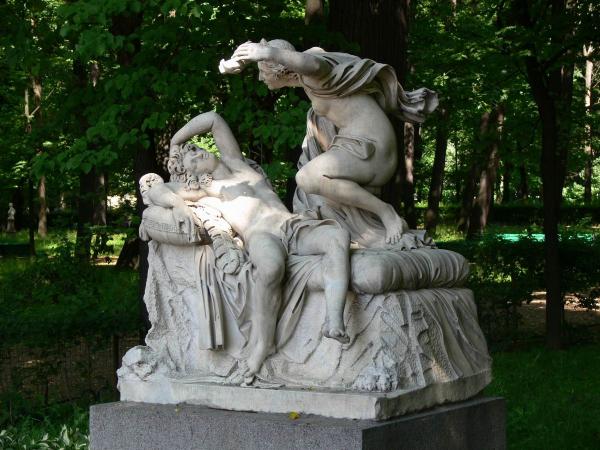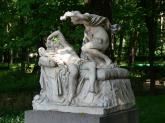Cupid and Psyche
End of the 17th century
- Marble. 150 х 130 х 101
- Location in museum The Summer Garden
- Period Late 17th century – the 18th century
- Mythological Subject
- Share
|
Not far from the Swan Canal pier the “Cupid and Psyche” statuary is situated. This work’s purchase has the following history: Peter I’s authorised delegate Yuri Kologrivov made a number of works of art purchases in Italy, among which there was the “Cupid and Psyche” statuary, which was named “Cupido and Psysha” in Russia. The arrangement was made in Rome in 1719 and, according to Yuri Kologrivov’sinformation, the sculpture was performed after Giovanni Lorenzo Bernini’s drawing for Christina, queen of Sweden. The name of the work’s author is unknown. Allegedly, it could be Giulio Cartari. Here is what Kologrivov wrote to the emperor’s secretary Makarov about his purchase: “… the plot when Psychy fell in love with the sleepy Cupid and I fell in love with them both. Without joking, wonderfully made and can be considered a wonder in liveliness and mastery”. And indeed, “Cupid and Psyche” on the Summer Garden alley seem to be characters of the ancient myth come alive. The statuary, which is a real rarity, was initially established in the “Grotto” pavilion. The subject is taken from the writing “Metamorphoses” by the ancient Roman author Apuleius (2d century AD). In Apuleius’s narration Psyche was so beautiful that made Venus, the goddess of beauty, jealous, so she sent her son Cupid to wound Psyche. But when Cupid saw the girl he did not hurt her but took her to his chambers secretly and visited her at night in complete darkness having forbidden her to see his face. Deceitful and jealous sisters encouraged Psyche to break the ban and she tried to catch a glimpse of her lover’s face using a night lamp. Here we can see a beautiful myth fixed in marble: admiring Psyche leans to her mysterious husband. In a moment a hot drop of oil from the lamp will wake Cupid and in anger he will leave Psyche. The girl will have to overcome many ordeals before she finds her lover again. This statuary is distinguished by its author’s mastery, subtlety of performance, perfection of composition, elegance of modelling, spirituality and aching feeling of tenderness. Without any doubt it is one of the best works of Baroque plastic arts in the Summer Garden. |

